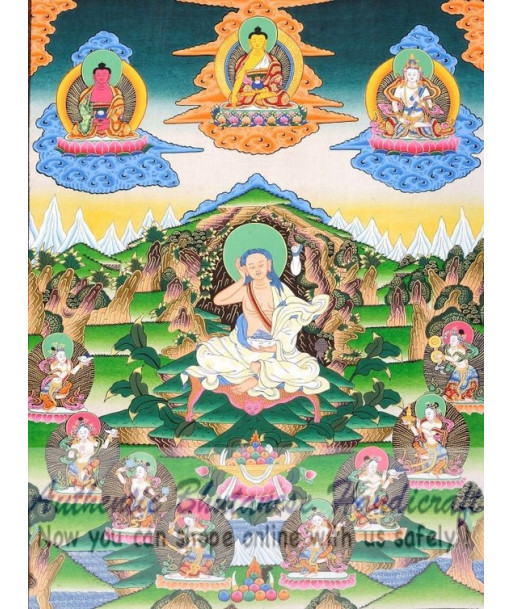- -50%





A **Milarepa Thanka** painting features Milarepa, one of Tibet's most revered yogis and poets, known for his profound spiritual realization and transformative life story. Milarepa, whose name means "The Cotton-Clad One," is celebrated for his deep meditation practices and teachings on the path to enlightenment.
 Security policy
Security policy
(edit with the Customer Reassurance module)
 Delivery policy
Delivery policy
(edit with the Customer Reassurance module)
 Return policy
Return policy
(edit with the Customer Reassurance module)
A **Milarepa Thanka** painting features Milarepa, one of Tibet's most revered yogis and poets, known for his profound spiritual realization and transformative life story. Milarepa, whose name means "The Cotton-Clad One," is celebrated for his deep meditation practices and teachings on the path to enlightenment.
### Key Elements of Milarepa Thanka Painting:
1. **Central Figure**:
- **Milarepa**: The main figure in the thanka is Milarepa, often depicted with the following key characteristics:
- **Appearance**: Milarepa is usually shown with a serene and contemplative expression. He often has a dark complexion and is depicted wearing simple, ragged robes made of cotton, which reflect his ascetic lifestyle.
- **Posture**: He is commonly depicted seated in a meditative posture, either on a rock or a lotus throne, demonstrating his deep meditation practice. Sometimes, he is shown in a relaxed or reclining position, reflecting his renunciation and ease in the natural world.
2. **Attributes**:
- **Dharma Text**: Milarepa might hold a Dharma text or prayer beads, symbolizing his commitment to the teachings of Buddhism and his role as a practitioner of profound wisdom.
- **Mugwort (Artemisia)**: Occasionally, he is depicted holding a staff or a bundle of mugwort, which was used in traditional Tibetan medicine and practices.
3. **Iconography**:
- **Mountain Landscape**: The background of the painting often features rugged mountain landscapes, reflecting Milarepa's life of solitude and meditation in the high Tibetan Himalayas. The mountains are symbolic of his spiritual journey and the challenges he overcame.
- **Sky and Clouds**: The painting might include an expansive sky or clouds, emphasizing the vast and boundless nature of Milarepa’s realization.
4. **Background and Surroundings**:
- **Cave Setting**: Sometimes, the thanka might include imagery of a cave, symbolizing the places where Milarepa practiced his meditation and achieved enlightenment.
- **Spiritual Symbols**: The background may include various auspicious symbols and deities associated with Milarepa’s life and teachings, adding depth to the spiritual context of the painting.
5. **Mantras and Texts**:
- **Inscriptions**: Tibetan script or mantras related to Milarepa's teachings and life story may be inscribed around or within the painting. These texts often highlight his famous poems and spiritual insights.
### Significance:
- **Spiritual Inspiration**: Milarepa is celebrated for his profound realization and transformation from a life of negative karma to one of deep enlightenment and wisdom. The thanka serves as a source of inspiration for practitioners, illustrating the power of dedication and the potential for personal transformation.
- **Teachings and Legacy**: The painting acts as a reminder of Milarepa’s teachings on compassion, meditation, and the path to enlightenment. His life story and teachings are central to Tibetan Buddhism, and the thanka helps to preserve and convey these teachings.
- **Meditation and Devotion**: The Milarepa Thanka is used in meditation and devotional practices to connect with Milarepa’s wisdom and attain his spiritual qualities. Practitioners seek his blessings for guidance on their own spiritual path.
The Milarepa Thanka is a profound spiritual object that reflects the depth of Milarepa's teachings and the significant role he plays in Tibetan Buddhist tradition as a symbol of spiritual perseverance, enlightenment, and poetic expression.